24.05.2020
Dragon crew runs through launch day dress rehearsal
Astronauts Doug Hurley and Bob Behnken donned their SpaceX-made launch and entry flight suits Saturday and rode to pad 39A at the Kennedy Space Center in a final dress rehearsal before launch day.
They rode in a Tesla SUV with the license plate “ISSBND” — noting the crew’s destination of the International Space Station.
The two NASA astronauts — each a veteran of two space shuttle flights — departed crew quarters at Kennedy’s Neil Armstrong Operations and Checkout Building a little before 1:30 p.m. EDT (1730 GMT) Saturday.
After a 20-minute drive to the launch pad, Hurley and Behnken rode an elevator to the 265-foot-level of the seaside complex, walked across the 50-foot crew access arm, and boarded SpaceX’s Crew Dragon capsule. The strapped into their seats and performed their initial spacecraft fit checks, following the same timeline as launch day.
The countdown was expected to halt an hour prior to the simulated launch time of 4:33:33 p.m. EDT (2033:33 GMT), the same time of the Crew Dragon’s scheduled liftoff Wednesday. The astronauts were expected to exit the Crew Dragon spacecraft within a half-hour after the simulated scrub, then return to crew quarters for a debriefing.
Saturday’s “dry dress rehearsal” was the final practice session for the astronauts with the Crew Dragon capsule they will fly into orbit.
A preliminary forecast issued Saturday by the U.S. Space Force’s 45th Weather Squadron predicts a 40 percent probability of favorable conditions for launch Wednesday. That does not take into account additional weather restrictions for a crewed mission, such as favorable winds and sea states downrange in the Atlantic Ocean.
Backup launch opportunities are available May 30 at 3:22 p.m. EDT (1922 GMT) and May 31 at 3 p.m. EDT (1900 GMT).

















SpaceX gets official ‘go’ from NASA for upcoming astronaut launch debut
Days before the final test flight and first crewed flight of SpaceX’s Crew Dragon capsule, Demo-2, representatives from SpaceX, NASA, and the International Space Station met for an intensive Flight Readiness Review (FRR) to determine whether or not the historic mission could proceed toward a May 27th, 2020 launch attempt.
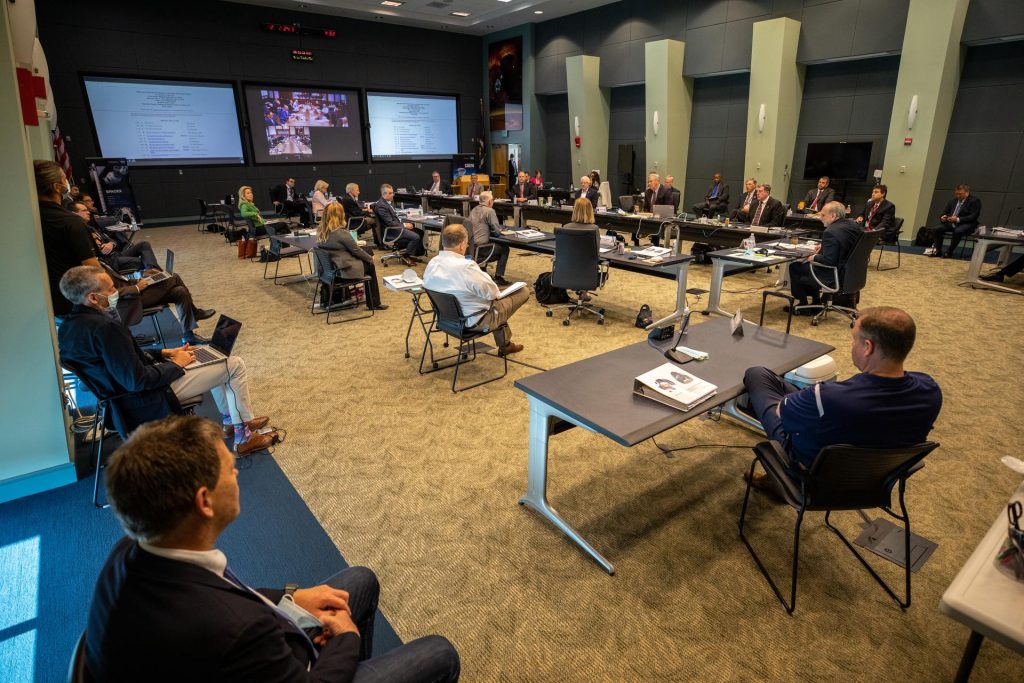
Leaders from SpaceX and NASA such a NASA’s Commerical Crew Program Manager, Kathy Lueders; International Space Station Program manager Kirk Shireman; SpaceX’s director of Crew Mission Management, Benji Reed in conjunction with Russian and Japanese representatives from the International Space Station partnership came together to discuss the findings of previous, specialized reviews, close out any remaining action items, and give the official nod of approval for SpaceX to send astronauts to orbit for the first time. NASA Associate Administrator, Steve Jurczyk, led the review in place of Doug Loverro who recently resigned as chief of NASA’s human spaceflight program.
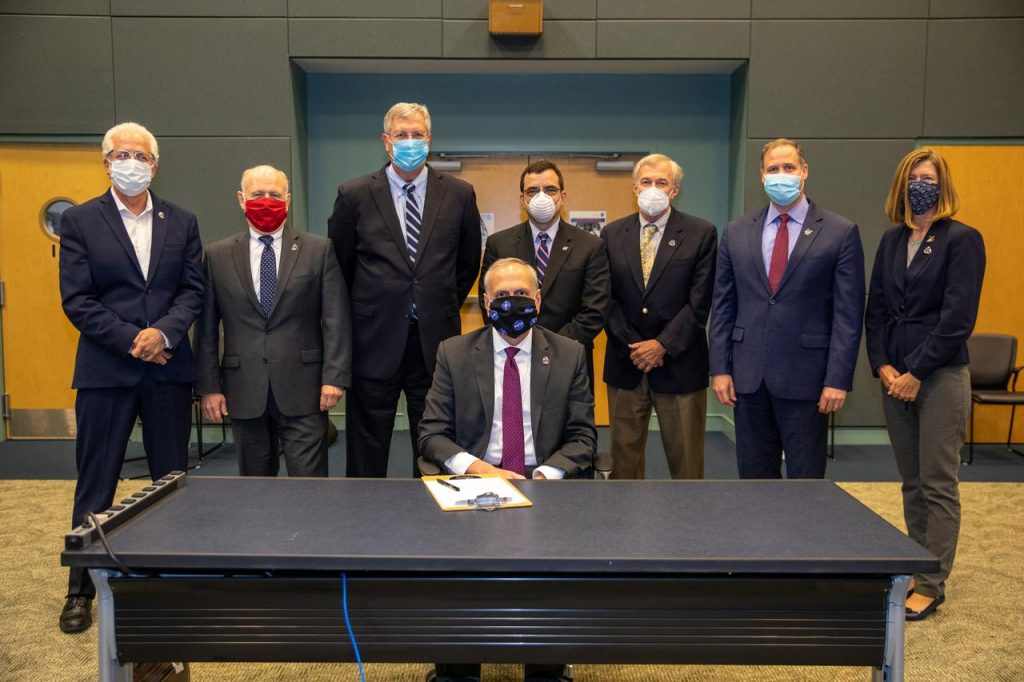
The standard practice joint FRR that occurs ahead of any crew launch comes after a series of previously held independent specialized reviews – such an engineering review of the Crew Dragon capsule and a flight test rate review led by Kathy Lueders and the Commercial Crew Program team. Initially intended to last just one day, the FRR began on Thursday (May 21st), extended to the end of the business day, and continued into Friday (May 22nd). After a day and a half of intensive review and conversation, Steve Jurczyk stated that “We did a thorough review of all of the systems and all the risks, and it was unanimous on the board that we are go for launch.”
NASA administrator, Jim Bridenstine spoke at a post review news conference stating that the FRR was a “time to speak up if there are any challenges and there were. There were conversations that were had that were very important to be had.” He also stated that there are still “a lot of checks to do, but the (flight) readiness review was good and we are a go.”
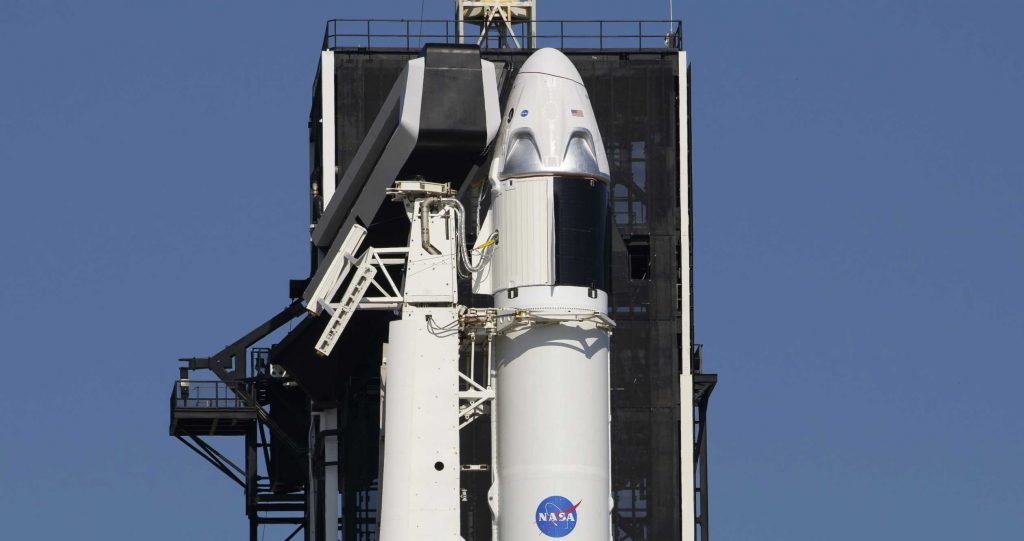
For Demo-2, the successful FRR is a crucial pathfinding step to confirming launch, however not the last. During the follow-up news conference, SpaceX’s Director of Crew Mission Management, Benji Reed, stated that the go for launch is permission to proceed in the launch sequence, but “really it’s a go to the mission,” referring to the fact that Demo-2 is an extended exercise of SpaceX’s entire human spaceflight system. Demo-2 will every step of the sequences from launch, to docking, to returning NASA astronauts Bob Behnken and Doug Hurley home safely. Reed went on to say that “there’ll be constant vigilance and watching of the data and observations as we go through the mission.”
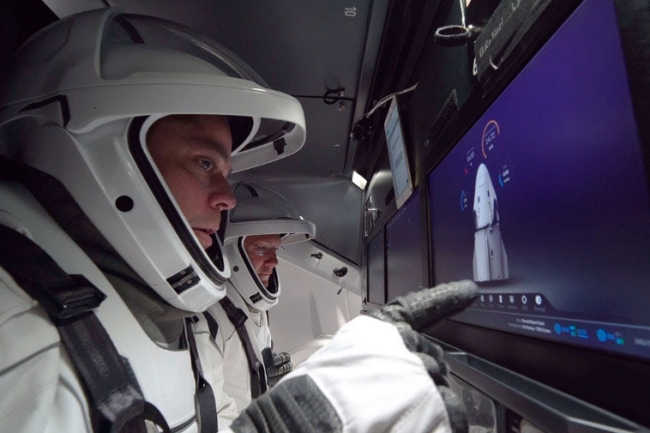
In order to pass this final test flight, SpaceX will have to prove beyond a shadow of a doubt that Falcon 9 and Crew Dragon are more than capable of delivering and returning astronauts safely to and from orbit. Perhaps the most important objective to be met is achieving NASA human rating certification of SpaceX’s human spaceflight system. In response to a question regarding human rating by CNBC reporter Michael Sheetz, Steve Jurczyk stated that the Demo-2 FRR was an “intermittent interim human rating certification review – validated that this system meets the human rating certification requirements for the Demo-2 mission and those requirements feed forward to future missions, including the Crew-1 mission. We will have a final human rating certification review after Demo-2, before the Crew-1 mission, just to certify the relatively small set of design changes between the Demo-2 system and the Crew-1 system, and at that point, we will deem the system human rating certified.”
A few final hurdles Demo-2 had left to clear is the static firing of the Falcon 9’s Merlin 1D engines and a dry dress rehearsal of launch day proceedings scheduled to occur Saturday (May 22nd) to ensure every kink is worked out of the system and everything is ready to go for launch. The dry dress rehearsal will encompass every aspect of launch day, from putting on the spacesuits to climbing into the Crew Dragon capsule. It is expected to end just before propellant loading would begin in the countdown.
Finally, SpaceX is expected to hold its own Launch Readiness Review with appropriate NASA teams in attendance on Monday, May 25th, “to make sure we’re go for each aspect, including go to come home,” as stated by Reed. Upon conclusion, the only thing left to do will be to load the astronauts and launch to the International Space Station, making history for SpaceX once again.
Quelle: TESLARATI
----
Update: 25.05.2020
.
RETURNING HUMAN SPACEFLIGHT TO THE UNITED STATES


SpaceX is targeting Wednesday, May 27 for Falcon 9’s launch of Crew Dragon’s second demonstration (Demo-2) mission from Launch Complex 39A (LC-39A) at NASA’s Kennedy Space Center in Florida. This test flight with NASA astronauts Bob Behnken and Doug Hurley on board the Dragon spacecraft will return human spaceflight to the United States.
The instantaneous launch window opens at 4:33 p.m. EDT, or 20:33 UTC, with backup instantaneous launch opportunities available on Saturday, May 30 at 3:22 p.m. EDT, or 19:22 UTC, and on Sunday, May 31 at 3:00 p.m. EDT, or 19:00 UTC. Tune in here to watch the launch webcast. Coverage will begin about 4 hours before liftoff.
Demo-2 is the final major test for SpaceX’s human spaceflight system to be certified by NASA for operational crew missions to and from the International Space Station. SpaceX is returning human spaceflight to the United States with one of the safest, most advanced systems ever built, and NASA’s Commercial Crew Program is a turning point for America’s future in space exploration that lays the groundwork for future missions to the Moon, Mars, and beyond.
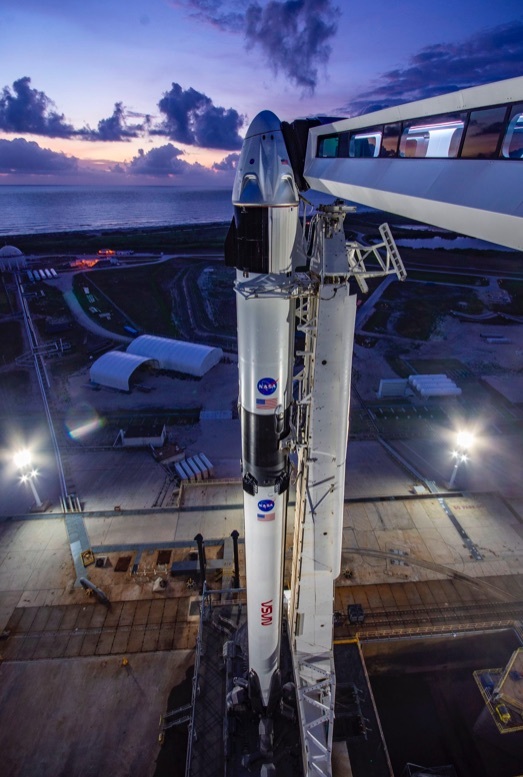
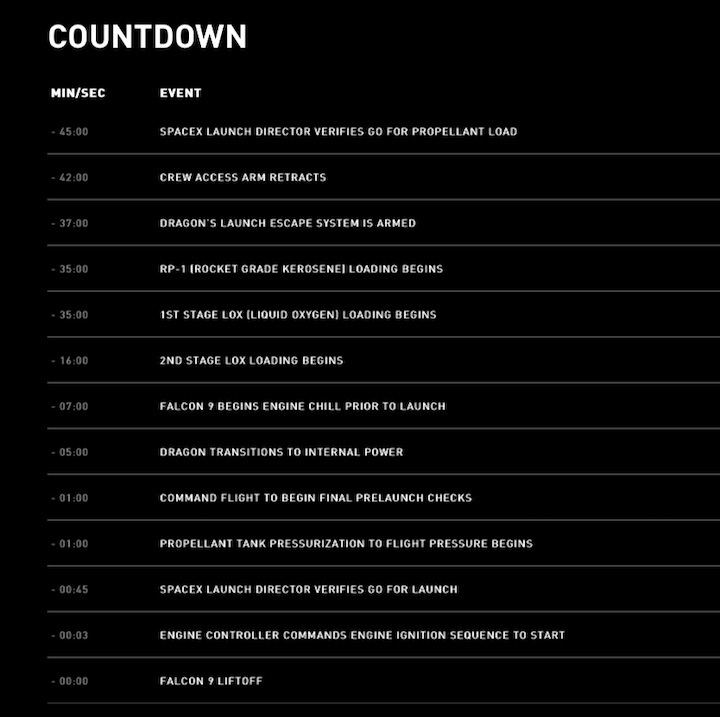
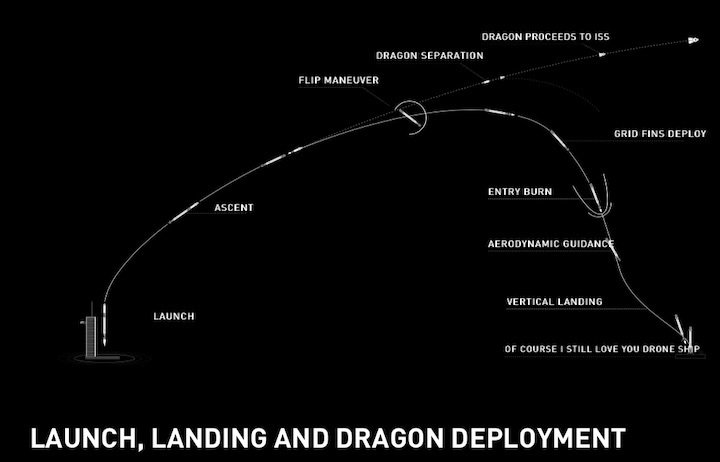





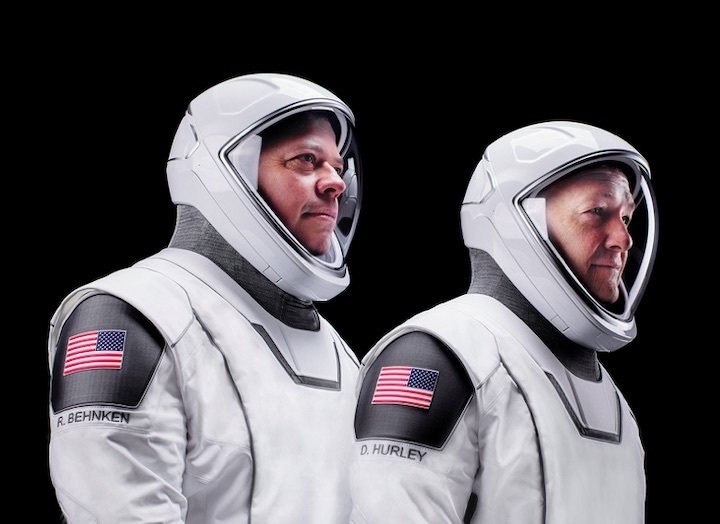
Quelle: SpaceX
----
Update: 26.05.2020
.
Stormy weather puts damper on SpaceX's 1st astronaut launch
Stormy weather is threatening to delay SpaceX's first astronaut launch
CAPE CANAVERAL, Fla. -- Stormy weather is threatening to delay SpaceX’s first astronaut launch.
A SpaceX rocket is scheduled to blast off Wednesday afternoon from Kennedy Space Center, carrying a Dragon capsule with NASA astronauts Doug Hurley and Bob Behnken to the International Space Station. It will be the first time astronauts launch from Florida in nine years and a first for a private company.
The manager of NASA's commercial crew program, Kathy Lueders, said everything was progressing well — at least on the ground.
“Now the only thing we need to do is figure out how to control the weather,” she said Monday evening as rain continued to drench the area. “We're continuing to be vigilant and careful and make sure we do this right.”
Forecasters put the odds of acceptable launch weather at 40%. But that doesn’t include the conditions all the way up the U.S. and Canadian coasts and across the sea to Ireland — a complicated mix of measurements unique to the Dragon crew capsule.
The Dragon’s emergency escape system can kick in, if necessary, all the way to orbit. If that happens, the capsule will need relatively calm wind and seas in which to splash down.
SpaceX will have at least two recovery ships deployed off Florida, and NASA will have two military cargo planes ready to take off. Additional planes will be stationed in New York and England to assist with a potential water rescue, according to Lueders.
Hans Koenigsmann, a vice president for SpaceX, said the launch control team will incorporate global weather patterns and models to determine whether it's safe to launch.
“If the weather gods are working with us," he said, liftoff will occur at 4:33 p.m. SpaceX has a split-second launch window.
The good news is that the tropical weather headed toward Cape Canaveral should be gone in a couple days, with conditions also improving up the Eastern Seaboard later in the week.
If SpaceX doesn't launch Wednesday, its next attempt would be Saturday.
Quelle: abcNews
----
Update: 27.05.2020 / 8.45 MESZ
.
T-1 Day: NASA, SpaceX Ready to Bring Human Spaceflight Back
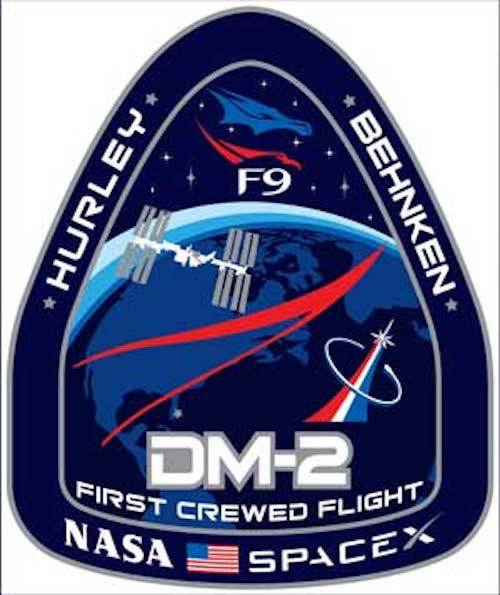


The International Space Station (ISS) is primed to receive its sixth visiting vehicle of 2020 in the coming days, although of a kind unseen in almost a decade and of a nature never seen before. Retired Marine Corps Col. Doug Hurley, who piloted the final voyage of the Space Shuttle, and former chief astronaut and Air Force Col. Bob Behnken, a former NASA chief astronaut, will launch from historic Pad 39A at the Kennedy Space Center (KSC) in Florida at 4:33 p.m. EDT Wednesday, 27 May.
Flying atop a Falcon 9 booster, theirs will be the first mission by U.S. astronauts, aboard a U.S. spacecraft and from U.S. soil since the end of the shuttle program in July 2011, as well as being the first-ever time that humans will have traveled into low-Earth orbit in a wholly commercial vehicle.











Quelle: NASA
